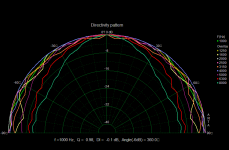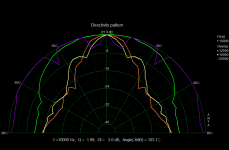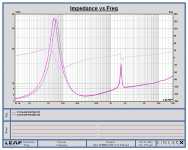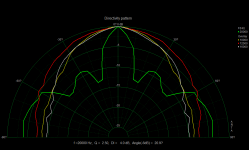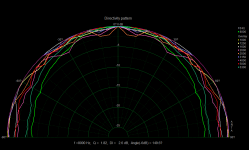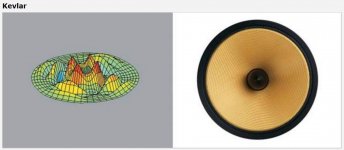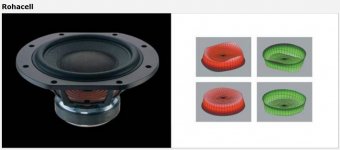The quoted efficiency seems to be 85dB/W, which fits perfectly well.Which doesn't fit with the Cambridge Audio 90dB/W claimed efficiency at all
I just finished on- and off-axis response measurement of a TEBM65C20F-8 (BMR65). I used ARTA as the core measurement software. A nice tool, Arta Recorder (Software) was used for semi-automatic polar measurement. The BMR65 was mounted on a baffle with its rear back closed with volume 17 l. The baffle size is 1.2 m x 1.2 m. Driver location on the baffle is offset to reduce diffraction ripple.
The measurement microphone (Presouns PRM1) was 0.5 m from the BMR65 panel. Presouns AudioBox 44VSL was the USB audio interface. Measurement was taken from 0 deg to 90 deg, 5 deg step.
The first figure shows freq. responses (0 deg to 90 deg per 10 deg). Polar pattern below 10 kHz is the second figure (all 5 deg step data used). Third figure shows polar pattern for higher freq.
The measurement microphone (Presouns PRM1) was 0.5 m from the BMR65 panel. Presouns AudioBox 44VSL was the USB audio interface. Measurement was taken from 0 deg to 90 deg, 5 deg step.
The first figure shows freq. responses (0 deg to 90 deg per 10 deg). Polar pattern below 10 kHz is the second figure (all 5 deg step data used). Third figure shows polar pattern for higher freq.
Attachments
Last edited:
I just finished on- and off-axis response measurement of a TEBM65C20F-8 (BMR65). I used ARTA as the core measurement software. A nice tool, Arta Recorder (Software) was used for semi-automatic polar measurement. The BMR65 was mounted on a baffle with its rear back closed with volume 17 l. The baffle size is 1.2 m x 1.2 m. Driver location on the baffle is offset to reduce diffraction ripple.
The measurement microphone (Presouns PRM1) was 0.5 m from the BMR65 panel. Presouns AudioBox 44VSL was the USB audio interface. Measurement was taken from 0 deg to 90 deg, 5 deg step.
The first figure shows freq. responses (0 deg to 90 deg per 10 deg). Polar pattern below 10 kHz is the second figure (all 5 deg step data used). Third figure shows polar pattern for higher freq.
Interesting measurements as always on BMRs, Panson. 🙂
Have you got an impedance plot? That trough in around 1.7k looks nasty pasty...
Here is a sample driver's impedance curves. Curve 21 is for 0.1 V driving signal level. Curve 24 is for 1.0 V driving signal level. As you expected, there is a resonant at about 1.6x kHz.
I found a paper at Naim web site. Dips occur at modes. The paper is attached.
I found a paper at Naim web site. Dips occur at modes. The paper is attached.
Attachments
Last edited:
Here are polar plots of a smaller BMR available at RS Buy Speaker Drivers HiWave Speaker Driver HIBM36S12-8/A, 12W, 8Ω, 24W HiWave HIBM36S12-8/A online from RS for next day delivery.. This one has much wider dispersion up to 16 kHz. 20 kHz is also very good too.
Attachments
Here is a sample driver's impedance curves. Curve 21 is for 0.1 V driving signal level. Curve 24 is for 1.0 V driving signal level. As you expected, there is a resonant at about 1.6x kHz.
I found a paper at Naim web site. Dips occur at modes. The paper is attached.
Very nice work, Panson. Makes me wonder
1. if that dip causes the driver to sound congested and lifeless
2. if there's any way I can fix it
According to Naim's whitepaper, apparently by strategically placing masses, that peak could easily be fixed? And weird enough there's only one major dip rather than multiple, (i.e. 1.6kHz x 2^n, may n be an integer), perhaps they have added mass already but not enough to save the driver, or the "cone" is too well damped to show those modes? If I could get hold of these guys, I would be very temped to experiment with sticking blu tack patches on them or try Planet 10's dot-painting treatment ...
Any interesting way (dot-paint) to do tuning! Where I can get measurement data of the result? Are they doing such painting in a scientific way?
Did you try blutack on other drivers?
Did you try blutack on other drivers?
Any interesting way (dot-paint) to do tuning! Where I can get measurement data of the result? Are they doing such painting in a scientific way?
Did you try blutack on other drivers?
Panson, FYI
standingwaves
I still don't know if there's any scientific way to perform that, but I can imagine it should work on BMR drivers better.
You can find that (study) in B&W’s Rohacell® and Kevlar cones.
Bowers & Wilkins Loudspeakers - Technologies
Bowers & Wilkins Loudspeakers - Technologies
Attachments
- Home
- Loudspeakers
- Full Range
- TEBM65C20F-8 BMR driver

